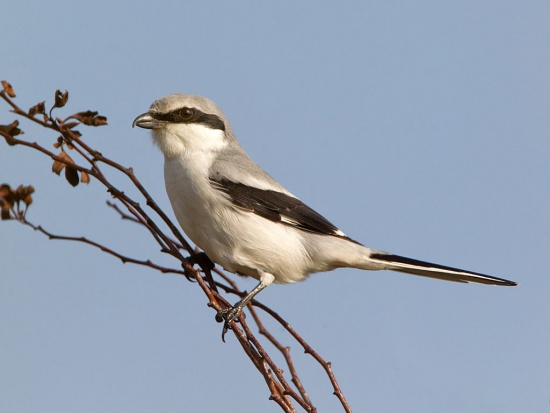| Looking for something? Search for it here. |
Welcome to the Opus, an interactive, multimedia encyclopaedia that anyone can edit. You can use the Opus to find out about everything to do with birds - from the birds themselves to the places you can find them.
Includes Steppe Grey Shrike
Identification
Adult
Length 22-26 cm (8½-10¼ in), weight 50-80 g
- Grey head and back
- White belly, throat, flanks and chest (flanks often faintly barred pale grey in females)
- Black wings with white patch at base of primaries
- Medium-long tail, black with white outer feathers
- Black mask on face extending to base of bill, but not over top of bill
- Distinctive stout, hooked black bill
Juvenile
- Similar to adult except duller and faintly barred, with dark grey where adult black, and slight pinkish base to bill.
Variation
Populations differ in color of both upper- and underside, extent of white on scapulars, wings and tail, size and shape of black mask and bill, and in presence vs absence of and if present in color of supercilium. See more in the taxonomy section.
Taxonomy
Complex, and potentially liable to further revision[2]. A large number of subspecies were split as Southern Grey Shrike. One subspecies was left there but renamed to Iberian Grey Shrike, but most were returned to Great Grey Shrike for now. Populations from northeastern Asia and North America formerly included here have recently been split as Northern Shrike[1, 2]. Whether more splits are coming is an open question.
Subspecies
Clements recognizes these subspecies[1] (however, notice that not all resources agree on which subspecies are valid):
- L. e. excubitor
-
- Small white patch at base of primaries; minimal white above black mask
- L. e. homeyeri
- Balkan Peninsula to southern Ural Mountains and western Siberia
- Large white patch at base of primaries; broader white band.....
Behaviour
Breeding
Most pairs are monogamous, with rare occurrences of polygyny.
In Europe, egg laying mostly happening March to June (including replacement clutches. Pairs usually only raise one brood, so laying again is a sign of a replacement clutch). Most nests are high above ground, averaging 15.5 m in Europe. Clutch size 3-9 eggs, with most pairs in Europe laying 6-7 eggs.
Nest is made by both sexes but incubation almost exclusively by female; she is fed during this period by the male, and this continues initially after hatching, but later, both parents participate in feeding young. Breeding success higher in northern than in southern populations.
Vocalisation
Song
A complex and variable medley of short liquid trills, whistles, chatter and harsh notes.
Call
A harsh shek-shek, grating jaaeg, rapid rasping aak...aak, a sharp metallic beek.
If you're looking for a particular bird, place, or anything else related to the birding world, try searching for it using the search box at the top, or to the left, of this page. You can also get an overview of all the birds, bird song, locations or other wildlife by using the tabs above.
- Articles: 13,242
- Files: 24,337




